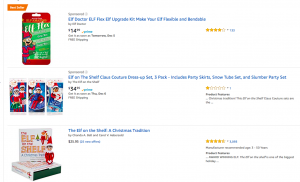Sections
Google vs. Amazon: How to Optimize Your Holiday eCommerce Campaigns for Success
Reading Time: 5 minutes
Phew, you made it through Black Friday and Cyber Monday and hopefully you were able to take a little breather. Now, with just a couple weeks until your last Christmas ship date, it’s time to go, go, go! Last-minute shoppers sometimes spend weeks browsing holiday items but time is running out for them to complete their purchases, and you need to be ready to help them along.
Below we’ll focus on two major shopping search engines—Google and Amazon. Google Shopping has been a go-to player for consumers to validate pricing and make purchases. And, Amazon, with its quick shipping options and large retailer market, is a leading one-stop shop. In fact, research shows that more and more consumers are going to Amazon for product discovery. Read on to learn our expert tips on how to best optimize your eCommerce campaigns to increase your sales via Google and Amazon channels this season.
Google Shopping
Did you know, according to Google, only 18% of shoppers confine their buying to the Black Friday/Cyber Monday weekend? While more shoppers are spreading out their holiday purchases throughout the season, there is still a huge demand for last-minute shoppers who seek speedy and stress-free transactions.

This is especially true for mobile shoppers who want to avoid retail stores this season. Google Analytics research says more than 40% of online transactions are now done on mobile, making it a great sales opportunity platform. “Mobile-friendly advertisements and click-to-call buttons for customers with additional questions are great ways to attract and keep mobile shoppers,” says Alisha Chocha, Your Marketing People’s Paid Search Manager.
Even if you’ve already finalized your Google Shopping ads, keep reading to see if you’ve done the following to boost visibility and sales.
1. Double-check your inventory.
Make sure your products are in stock and that correct prices are showing. The last thing you want is to miss out on sales because you don’t have the product available. Quick tip: If you notice a lot of traffic to your product listing, but see no to low conversions, check the product listing information and make sure they match. For example, if the pricing is higher on your site than your ad, people will surely bounce.
2. Review your Shopping management campaigns.
Now is the time to increase bids on best-selling items to increase reach, add merchant promotions to highlight your offers (like 20% off coupons, etc), and add negatives to defer costly traffic. Another expert tip is to optimize your feeds according to device (desktop vs. mobile). In one client’s shopping campaign, Your Marketing People targeted mobile and desktop devices separately and effectively decreased the client’s CPC by 60%.
3. Optimize your product feed to increase reach.
- Images. Your images should be high quality (at least 800 x 800 pixels) to achieve a good CTR.
- Titles. Remember that only the first 70 characters (out of the 150 limit) are visible in the ad. Your titles need to be clear, concise, and relevant to each product.
- Descriptions. All item descriptions should be keyword-rich and meaningful for consumers. Do some additional research now on Google Trends or other sites to ensure your descriptions include top search query keywords.
- Categories. Everything should be categorized into the correct product type to make it easier for consumers to find you.
- Product Groups. There are almost endless options when optimizing product group attributes that it may seem overwhelming at first. We can help sift through the attributes that will benefit you the most. Some product group optimization examples include: Channel (whether it’s sold locally, online, or both); Brand (listing the product manufacturer); Category (can be a sorted into a string such as Women’s > Apparel and Accessories > Clothing > Outerwear).
Amazon
For many shoppers, Amazon is a one-stop holiday gifts destination, with a variety of seller options for each product, and of course, Prime same-day or 2-day shipping. In addition, consumers are increasingly using Amazon to find products, for example, using search queries such as: “best tech gifts” or “best toddler toys.”
It’s more important than ever to optimize your Amazon feeds, especially since recent research notes that 70% of Amazon shoppers don’t click past the first page of search queries. High visibility through good rankings is crucial. The good news is that by taking quick action on the steps below, you can increase your keyword ranking efficiently and quickly, sometimes within hours. Here are a few things you should definitely be doing to optimize on Amazon.
1. Enter keywords into the back end.
After performing keyword research, make sure to use your most relevant keywords first within your product page on Amazon Seller Central, as there is a 250-character limit per field. You don’t need to use commas or other punctuation, simply putting spaces between each word is sufficient.
2. Create a good title.
In most cases, you’ll have a 250-character limit. Create a clear product title using top keywords and anything that sets your product apart, for instance, if it’s made of “all-natural” materials. Product descriptions are another area to include top keywords—just make sure you’re writing for the customer’s eyes and not the search engine’s algorithm.

3. Use high-quality product images.
Visual assets such as photos and videos really help sell your product once a customer clicks through to the product page. Images that are high quality and relevant to your product can really add value. Consider including lifestyle photos of people using your product and examples to illustrate product size.
4. Increase bids on Amazon PPC campaigns.
Running short-term PPC ads with broad and phrase match has the potential to quickly increase your holiday sales. Just watch your budget and ensure you’re staying on top of it. We’ve seen greater success in running more broad terms to capture more search queries.
Planning for the Year Ahead
The last-minute holiday rush is upon us, and hopefully, by implementing the optimization tips referenced above, you’ll be on your way to ending the year with higher sales.
Remember after all of this, you should review which campaigns worked best and especially what strategies helped your sales reach their highest. Start with the marketing channels that brought in the most revenue, and consider adjusting your marketing budget to push more dollars toward those outlets. A detailed and well-executed eCommerce SEO plan can greatly boost visibility and revenue. If you are looking for more direction on where to go from here, our eCommerce experts are standing by to offer guidance.







